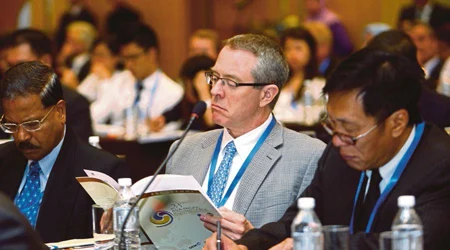Article by Tan Sri Rastam Mohd Isa which appeared in New Straits Times, 11 May 2018
Asean-ISIS network have organised the Asia-Pacific Roundtable (APR) in Kuala Lumpur. The threeday 32nd APR began on May 7 and ended on May 9.
After three decades, the APR remains a premier international conference that deliberates on vital strategic political, security and economic issues.
This year the organisers have elected to focus on the issue of disruption across various segments — people, technology, power and security — as the theme of the conference. In this digital age and amidst rapid and swirling changes occurring around us, disruption has affected every facet of our lives and activities.
The often-quoted adage by the philosopher Heraclitus, that change is the only constant, should not be surprising to contemporary observers of geopolitics, geostrategic and geoeconomic developments. Yet, when that change happens, many are often taken by surprise, especially if that change is disruptive.
Recent developments globally and in the Asia Pacific have clearly indicated that disruption and change have impacted states, businesses and people. Disruption is becoming part of the new normal in international relations, in trade and commerce and in domestic political, economic and sociocultural activities.
Much has been said of the evolving US-China relations and its impact on the global order and the region’s security architecture. The election and subsequent policy pronouncements and actions of United States President Donald Trump, and the continuing rise of China under a more powerful President Xi Jinping are disruptions and game- changers in their own right. Other stakeholders will have to adapt to the changing equation.
The realm of diplomacy and policymaking has also experienced disruption in many ways. A new, decentralised approach to diplomacy and policymaking has emerged, driven by digital technology, new media of mass communication, economic transformation and innovation, and the expanding global reach of institutions as varied as businesses, pressure-groups, charities and various other nonstate actors including terrorist organisations.
Methods and practices have changed significantly. Not too long ago it was considered revolutionary for leaders and ministers to phone, email or text each other, bypassing diplomats and their foreign ministries. Now, some leaders simply choose to Tweet their policies to the world, sometimes catching their own officials by surprise. This offers a challenge to officials and other interested stakeholders to understand the nuances and to implement the policies.
As an integral and important part of the Asia-Pacific, Asean will not be immune to the impact of the disruption and change. Asean is fully aware that it has to deal with challenges that are increasingly transboundary, multi-faceted, and multi-sourced in nature.
These challenges include the difficult task of maintaining Asean’s centrality and independence amidst the increasing competition between East and West, in particular, between “America First” and a rising China.
Is Asean resilient enough to face these disruptive challenges? The recognition is there and Asean leaders have articulated this in the “Asean Leaders Vision for a Resilient and Innovative Asean” which they adopted at the 32nd Asean Summit in Singapore on April 28.
As usual, the proof of how serious the Asean member states regard that document would lie in the work that would be put in to implement that vision in addition to the other vision documents adopted by the Asean leaders in the last two years since the declaration on the Asean community.
Disruption and change would not always bring about negative results. It is dynamic for either good or bad. Recent developments in the Korean Peninsula, for example, indicate an opportunity for a denuclearised peninsula and less competition but greater cooperation in Northeast Asia.
The approach taken by Trump and the good chemistry developing between the two Korean leaders have served to disrupt the decades-long status quo of tension and volatility in the area.
The prospects for lasting peace would bode well for all in the region.
There are other issues that could be discussed when deliberating on disruption and change in the region: globalisation and populism; democracy and the demand for greater political space; the impact of digitalisation and e-commerce on production, employment, business,trade and regional economic integration; the challenges of cybersecurity and terrorism, militancy and violent extremism.
These and the issues mentioned above were some of the topics covered at the 32nd APR. There were also sessions devoted to specific regions of the world: Southeast Asia, Northeast Asia, South Asia, Central Asia and West Asia.
The roundtable occured at an important moment in Malaysia’s history, i.e. GE14. The scholars, officials, diplomats, academics, think-tank heads and other participants at the roundtable had the opportunity to look at the various issues on the table with the Malaysian democratic process as an important backdrop.
The hope is that various stakeholders — governments, NGOs, the media, think tanks and academia — were able to contribute towards managing the continuously evolving regional architecture and its various disruptive challenges.
This would be crucial to the peace, stability and economic vibrancy of the Asia Pacific. Thus we all need to encourage and work for dialogue and cooperation, rather than rivalry and contestation in the region and in the wider world.
The APR has aimed to do just that since its beginning 32 years ago





